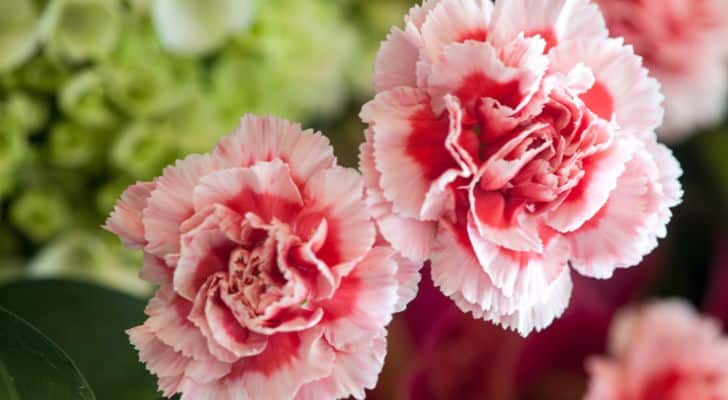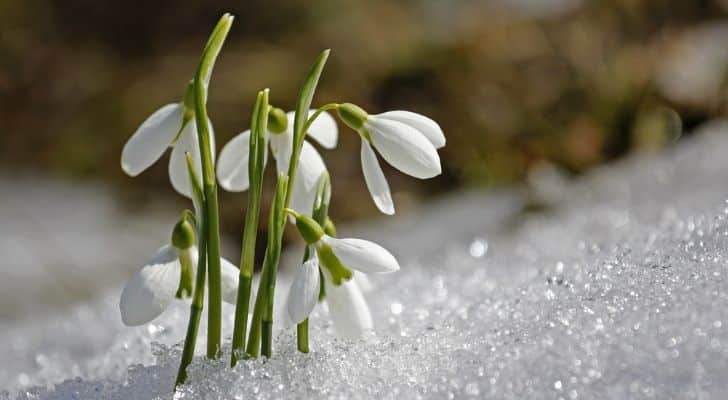Birth flowers are specified for every month, and January has two truly fascinating choices.
Carnations and snowdrops have been chosen to represent not only January but also the individuals born in this wintry month.
So whether you recognize these stunning plants or this is the first time you’re hearing of them, read on as we learn what makes these two flowers so unique.
10 Facts About Carnations.

Although both carnations and snowdrops are birth flowers for January, carnations are the primary birth flower.
Carnations are categorized into the genus Dianthus, which gets its name from the Ancient Greek dios, meaning god or divine, and anthos, meaning flower.
The specific scientific name for carnations is Dianthus caryophyllus. These flowers grow wild on the coasts of many Mediterranean countries, such as Spain, Italy, and Turkey.
Carnations are perennial and herbaceous plants. This means they live at least two years and have no persistent woody stem above the ground, such as a bush or small tree might have.
In this surprisingly broad lifetime, these vibrant flowers are able to grow up to 31.5 inches (80 centimeters) tall. That’s over two and a half feet!
They are known for their radiant colors and are associated with love, motherly affection, and distinction, partially explaining their association with Mother’s Day.
Anna Jarvis founded Mother’s Day in the US in 1907. She chose white carnations as the official flower of the day because they were her mother’s favorite flower.
There is a tradition at Oxford University to wear a carnation when taking an exam. In the first exam, students wear a white carnation, then pink for the following ones, and finally red for their last exam.
Carnations are known for their spicy fragrance and are one of the most popular commercial cut flowers.
There are two main groups of carnation: the perpetual flowering carnation and the border or garden carnation.
10 Facts About Snowdrops.

It isn’t clear where their name comes from, but plenty of theories exist. The most common idea says it comes from the German Schneetropfen (“snow-drop”). Schneetropfen were a type of white earring worn in Germany in the 16th and 17th centuries that looked similar to the flower.
Snowdrops get their scientific name, Galanthus, from the Ancient Greek gala, meaning milk, and anthos, meaning flower.
Snowdrops are largely used to symbolize spring, though they are often used in art and literature to also represent purity or religion.
The most common of these species is Galanthus nivalis, colloquially known as the common snowdrop. This is also the most widely known variety.
This widespread snowdrop species typically grows between 2.8-5.9 inches (7-15 cm) tall.
Snowdrops are native to certain areas across Europe and the Middle East. However, their popularity as ornamental flowers means they have been spread and cultivated in many other parts of the world.
Most snowdrops flower in late winter, a harsh time for most plants to grow, although some species flower a bit later in springtime.
Snowdrops contain ‘anti-freeze’ proteins to make it through these harsh winters. These fight the formation of ice crystals in the flower during winter, allowing them to survive frosty conditions.
They also have hardened tips, which gives them an advantage when piercing through cold, hard, or even frozen soil.
Finally, despite their renowned beauty, snowdrops are actually poisonous if eaten. There are also reports of skin irritation when handling them, so be careful if you’re admiring their beauty.
And there we have it: 20 incredible facts about January’s two fascinating birth flowers.
So whether it’s the widely appreciated beauty of snowdrops, despite their lesser-known poisonous side, or the scientific name for carnations, hopefully you’ve learned something today.
And if your birthday happens to be in January, then you’ve got double the reason to celebrate.
Not only do you have two flowers to choose from, but now you understand how truly lucky you are to have such fantastic choices.


















